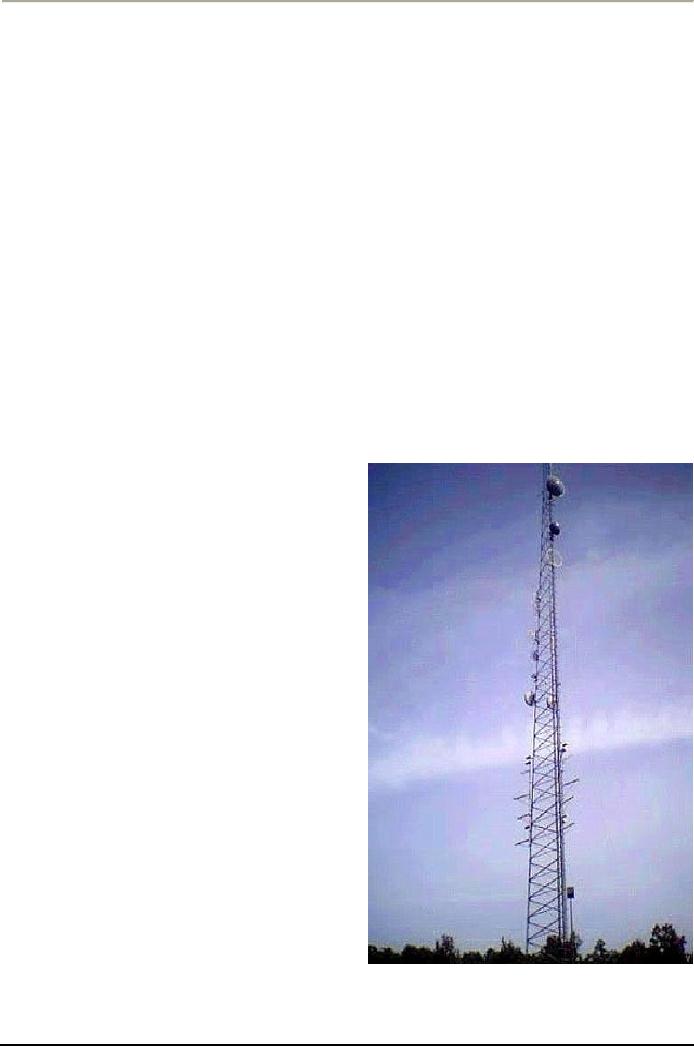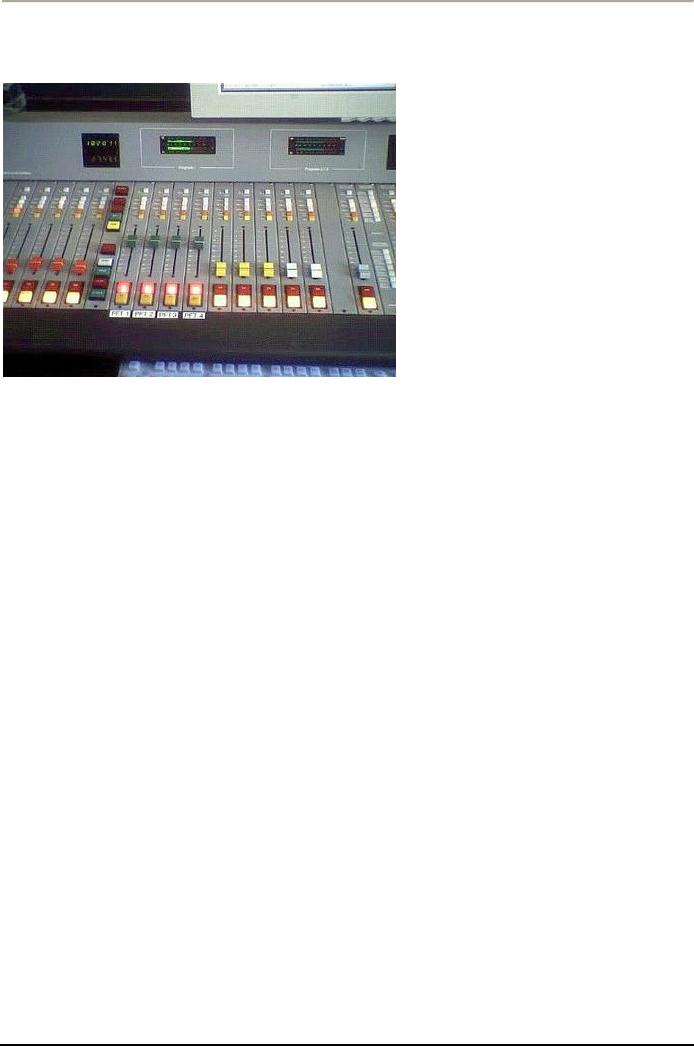 |
MICROPHONE TO TRANSMITTER:Amplifiers, Modulator, Transmitter |
| << FM – A NEW GENERATION IN BROADCASTING:Low Cost, The Difference |
| WRITING SCRIPT FOR RADIO BROADCAST:NEWS Script, Interviews >> |

Introduction
to Broadcasting MCM
411
VU
LESSON
19
MICROPHONE TO
TRANSMITTER
Since the
times of Marconi, the radio
inventor, so much has
changed from capturing
voice
and
sending it to end listeners.
The ordinary vinyl-records
are no more in use; in fact
they are
no
more seen as if part of
audio history, the recording
equipments are a
complete
transformation
in looks as well as functions
from the one used
almost a hundred years
ago.
The
typical radio station
microphones firmly placed in
the center of recording
table, the
recording
panels and the soundproofing
arrangements of early days
are a talk of
bygone
years,
only an old-uncle recalling,
sipping coffee and swaying
on the rocking chair in
some
pleasant
afternoon!
Students
of the radio broadcast need
to understand how technical
means have improved
over
the
decades and helped the
voice message to be taken to
the receiver, just as a
doctor these
days
needs to understand certain
functions of different machines
for a correct evaluation of
a
disease.
Microphone
From human voice to
electrical pulse
We
know that our ordinary
voice can't reach beyond an
ordinary distance however
high-
pitched
or strong it is. It is some
device, which helps us take
our voice beyond the
ordinary
length
of remoteness. This device is
the microphone also called
mike. Be it a public
announcement
speaker system, telephone,
pilot in a ship or aero
plane, mobile phone or
a
studio
the voice first enter
a microphone.
This
device changes the voice
(sound wave) into an
electric pulse and makes
matter so easy
for
the signal to be carried at a
desired distance in a matter of a
very small fraction of
time,
say
a second by any medium which
can afford to conduct
electricity.
There
was once a typical heavy
looking microphone. Now they
are so many in types
and
shapes.
Broadcast
type
Outdoor
recording
In-built
in various voice recording
and actuating devices
Small
stick with headphones
Collar
mikes
Mobile
phone mikes
Some
microphones are fitted with
wind-screens which block air
(breathing) interference
with
voice.
41

Introduction
to Broadcasting MCM
411
VU
Amplifiers
The
electric pulse goes to first
voltage amplifier which
works out the desired
amplitude of the
voice-signal
before it goes to power
amplifier, which provides
enough strength to it to go
into
the
next device. In the meantime
an oscillator helps the
signal to assume the form of
RF (radio
frequency).
Modulator
From
the oscillator and the
amplifier the signal goes to
modulator, an other active
device
which
converts the signal into a
form which perfects it for
transmission. It is from here
that a
signal
finally goes to antenna,
which may be a strong
transmitter itself.
Transmitter
Transmitters
are a complex device which
are capable to receive not
only radio frequencies
in
a
modulated form but also
enable the signals to be
transmitted, broadcast, at a
desired
frequency,
allotted by a governing authority
which controls transmission of
such frequencies
carrying
messages in any form.
A
radio station transmitter
looks like this
=>
The
Broadcasting House
The
broadcasting house, or a radio
station, is
equipped
with all these devices
but additionally
it
also has studios to produce
programs and
one
special for sending the
broadcast in real-
time,
always labeled at its door
as on-air.
At
a broadcasting house, the
voice has to be
treated
more carefully to give it a
desired pitch,
volume
and bass so that its
broadcasting value
is
ensured, it is passed through a
consol panel
as
you can see
here;
The
consol board through its
various functions
perfects
the voice signal for
broadcasting
through
the transmitter.
42

Introduction
to Broadcasting MCM
411
VU
Studios
At
least two types of studios
are essential at a broadcasting
house. One for live
transmissions
news, speeches by VIPs,
and
routine
programs, and others
for
production
of different programs
like
dramas,
music, talk shows
etc.
All
that is recorded at the
studios have
to
be put in the console board
to
ensuring
the voice and sound
quality
for
the broadcast.
Broadcasting
House & Transmitter
Not
that all the time a
broadcasting
house
has a transmitter at
its
premises.
At times a transmitter
may
be
away as far as 30 to 40 KM from a
broadcasting house due to
many reasons. In such
a
case,
the broadcasting house sends
ready-for-broadcast signals to the
transmitter through
ordinary
transmission lines, or microwaves.
The microwaves are very
high frequency waves
and
an ordinary radio can't read
them. A transmitter with
special devices receives
these
microwaves,
lower their frequency to
mega or kilo hertz which
could be tuned in by
ordinary
radios,
thus completing the cycles
of voice transmission from a
talent to the end
listeners.
Broadcasting
is not end of the road -
wait for
Podcasting
It
will sound and sound
it must, if I tell you that
you may have your
own radio station just
as
if
someone was talking about a
radio station in the first
decade of the last
century!
With
the on-line broadcasting
getting into the top
gear, the time has
already come for
starting
your
own radio station on your
web site through RSS
(really simple syndication)
and mp3 files.
News,
music, fun, talks, albums,
and advertisements- all in
your independent hands. More
in
the
chapter of interactive
broadcasting.
43
Table of Contents:
- BROADCASTING:Historical Facts about Radio, Wireless and Radio
- CLASSIFICATION OF PROGRAMS:NEWS, Language, Sensationalizing
- CURRENT AFFAIRS:Talk Shows, Discussions, Seminars, Live Shows
- OUTDOOR BROADCASTING I:VIP Movement, Suddenly Assigned Events
- OUTDOOR BROADCASTING II:Pakistan Day March Past, General Elections
- CURTAIN RAISER:Political, Financial, Sports, Academics
- RADIO FEATURE:Personality Features, Features on Events
- MUSICAL PROGRAMS:Classical Music, Light and Film Music, Folk Music
- RADIO DOCUMENTARY:Narrative, Dramatized, Imagination, Close to places
- DISC JOCKEY:Women in Focus, Daily/ Weekly Division, Making Titles
- VOICE IN BROADCASTING:Speech, Accent, Loudness, Stress
- NOISE:Physical, Medium itself, Problem at sender’s end, Semantics
- STUDIO:Drama Studio, Studios for Talk Shows/ Discussions, Music Studios,
- RADIO DRAMA I:Stage Dramas, Early Radio Dramas, Ethics, Classification
- RADIO DRAMA II:Selection of director, The Playwrights, Script, Voices
- ADVERTISEMENT – INCOME GENERATION:Similarities, More Analysis
- ADVERTISERS’ APPROACH:Dramatized, Dialogue based, News
- FM – A NEW GENERATION IN BROADCASTING:Low Cost, The Difference
- MICROPHONE TO TRANSMITTER:Amplifiers, Modulator, Transmitter
- WRITING SCRIPT FOR RADIO BROADCAST:NEWS Script, Interviews
- INTERACTIVE BROADCASTING:On-line, E-mails, Interview, Views in News
- REVISION:CURRENT AFFAIRS, RADIO FEATURE, MUSICAL PROGRAMS
- HISTORY OF TELEVISION:Early History, The Black & White Images, Color Television
- PAKISTAN TELEVISION (PTV):The Excitement, Timing, Live Broadcast
- BROADCASTING LAWS:Laws in the 19th century, Press Council of Pakistan
- REPLICAS OF RADIO BROADCAST:The Staff, News Reading, Programming
- NEW SCRIPT WRITING AND DIRECTION TECHNIQUES:TV Script
- SETS:Permanent Sets, Hot & Cover Sets, Special Sets, Economical
- CAMERA SHOTS – THE VISUAL LANGUAGE:Angle Shots, Movement shots
- LIGHTS IN VISUAL BROADCASTING:Light Temperature, Light and Distance
- INTERIOR AND EXTERIOR:NEWS and Interviews, Dramas and Music
- BROADCASTING AND MEDIA IMPERIALISM:The truth in the debate
- ENVIRONMENT OF TV BROADCAST:Optical Illusions, POV, Depth of Field
- BUDGET:First Part, Second Part, Third Part, The Sponsors
- COMPARISON AND CONTRAST OF DIFFERENT RADIO AND TV FORMATS:TV NEWS
- CURRENT AFFAIRS – FROM RADIO TO TV:Seminars, Interviews
- PRE-PRODUCTION:Brain Storming, Scripting a new program, Approval
- PRODUCTION & POST-PRODUCTION:Booking Shifts, Rehearsals
- TV ADVERTISEMENTS – MONEY WITH ENTERTAINMENT:Early Phase, Getting Spots
- ENIGMA OF MORE CHANNELS:The Investment, Fresh Ideas, Closure of channels
- ANCHORPERSON:Appearance and Confidence, Job Opportunities
- COMPARISON BETWEEN RADIO AND TV BROADCAST:The Difference, Script
- TERRESTRIAL TO SATELLITE TO CABLE TV:Cable Network, CD Channels
- CAREER IN BROADCASTING:Production, Direction, Lighting Director, Script Writer
- REVISION (LESSON 23 TO 44):Broadcasting Laws, PEMRA, Budget